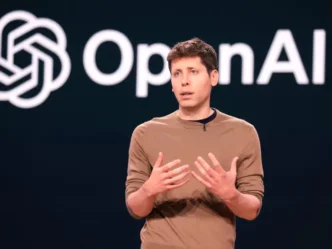Nvidia stole the spotlight this year in San Jose, packing the city’s convention center and downtown venues with a record-breaking crowd of 25,000 attendees for GTC 2025. The energy was palpable—sessions overflowed, with people lining hallways, sitting on floors, and scrambling to follow commands from organizers trying to keep order.
Sitting comfortably at the top of the AI world, Nvidia entered the event with soaring profits and a clear lead in the chip race. But beneath the celebration, serious challenges loomed. From U.S. tariff risks to rising competitors like China’s DeepSeek, and major AI customers planning their own custom chips, Nvidia faces a tricky road ahead.
Still, CEO Jensen Huang took the stage with his trademark confidence, rolling out next-gen GPUs, compact AI supercomputers, and even a fleet of adorable robots. His keynote was less about fanfare and more about delivering a message—Nvidia’s future is still bright, no matter what the market thinks.
At one point, Huang leaned into his pitch with a bold claim:
“The more you buy, the more you save… It’s even better than that. Now, the more you buy, the more you make.”
AI Demand and Doubts Fuel Investor Nerves inferred Nvidia During GTC 2025
If there was one takeaway from GTC 2025, it’s that Nvidia is determined to convince the world that demand for its chips isn’t going anywhere.
Huang doubled down on this message, addressing concerns sparked by DeepSeek’s new R1 model, a powerful reasoning AI that runs efficiently—potentially without Nvidia’s pricey hardware. Investors took notice earlier this year, fearing that such breakthroughs could reduce the need for Nvidia’s massive chips.
But Huang flipped the narrative. Reasoning models, he argued, aren’t a threat—they’re the future. And they’ll need even more computing power. To prove it, he unveiled the Vera Rubin GPU lineup, promising double the performance of Nvidia’s current Blackwell chips when running AI models, known as inference.
Yet, not everyone was convinced. Nvidia faces increasing competition from startups like Cerebras and Groq, offering cheaper inference hardware. Big players like AWS, Google, and Microsoft are also building their own chips, such as Graviton, Inferentia, TPUs, and Cobalt 100. Even Nvidia’s biggest customers—OpenAI and Meta—are moving toward in-house hardware.
That brewing competition might explain why Nvidia’s stock dipped 4% after Huang’s keynote. Some investors were likely hoping for a surprise—maybe an accelerated product launch or a moonshot reveal. They didn’t get it.
Nvidia didn’t ignore global politics either. With rising tensions over U.S. tariffs, the company assured attendees that, for now, there’s no immediate threat to its supply chain, especially since most of its chips come from Taiwan. Still, Huang stopped short of guaranteeing long-term protection, leaving the door open for future risks.
To hedge those bets, Huang made it clear Nvidia got the message from Washington loud and clear. He pledged to invest hundreds of billions of dollars into U.S. manufacturing—a move that could help secure Nvidia’s supply chain but also add significant costs to a company thriving on its massive profit margins.
Betting on Quantum and Personal AI Supercomputers
In a surprise twist, Nvidia used GTC 2025 to spotlight its growing interest in quantum computing—a field it had previously downplayed. Huang publicly apologized to leading quantum CEOs for triggering a minor stock crash earlier this year when he suggested quantum wasn’t useful for at least a few decades.
Now, Nvidia is launching the NVAQC center in Boston, teaming up with major players in quantum hardware and software. The goal? Use Nvidia’s chips to simulate quantum systems and advance quantum error correction—a crucial step toward practical quantum computing.
Looking to the near future, Nvidia also introduced personal AI supercomputers, positioning them as the next evolution of computing. The new DGX Spark and DGX Station—formerly Project Digits—allow users to build, train, and run AI models right from their desks. These machines don’t come cheap, costing several thousand dollars each. But Huang didn’t hold back on the hype.
“This is the computer of the AI age,” Huang declared. “This is what computers should look like, and this is what they’ll run in the future.”
Only time will tell if customers are ready to embrace that vision. But one thing is clear—Nvidia isn’t slowing down.













